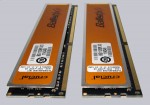
The memory modules are provided on a PCB with two bonded passive heatsinks (heatspreader), which are supposed to enhance the memory cooling also with higher frequencies and/or higher voltages. Thus one achieves on the one hand better overclocking results and on the other hand a longer life-time, whereby Crucial by the way grants lifelong warranty (Limited Lifetime Warranty) for the buyer (all information about manufacturer conditions are of course without guarantee by ocinside.de).
Instead of the JEDEC standard values of 1.50 Volt for DDR3 modules, these modules are officially designed for a higher voltage of 1.65 Volt to reach the fast CL8 timinings at DDR3-1600 without errors.
The fast timings and frequencies were programmed as XMP-1600 value (Intel Extreme Memory Profile) in the modules and can be detected on some mainboards like the EPP value (nVidia Enhanced Performance Profile) or the usual SPD value (Serial Presence Detect). If the motherboard supports XMP, the standard timings can be set to these higher frequencies automatically without much knowledge, otherwise one should adjust the correct RAM values manually in the BIOS, in order to get optimal results. Don’t hesitate to ask for help about the correct BIOS setup and the exact values in our forums.
Not 4GB on booting, but only 3GB in the BIOS or in the operating system …
It can occur that the memory capacity is only indicated as approx. 3GB instead of the 4GB, because 4GB RAM or any sizes with more than 2GB are still a case sui generis.Here at ocinside.de is a guide which contains among other things a table, how much RAM each operating system can support.

